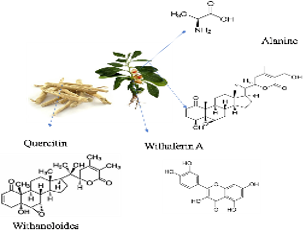Abstract
Ashwagandha, also known as Indian winter cherry, belonging to the Withania Somnifera Linn. (Solanaceae) family, (commonly available as Churna). Africa, the Mediterranean, and India are all home to this species. It is 30-50cm high and mainly found in the drier parts of India. Since it raises haemoglobin (red blood count) and hair melanin. Withania Somnifera is known as "Rasayana," which means "strong rejuvenator" in Ayurvedic jargon. In ethnomedicine, it is a well-known health food and herbal tonic that is used to treat cardiovascular diseases. It can be used as a single herb or as part of polyherbal or herbo-mineral formulations for humans. It is traditionally used to treat various diseases such as inflammation, asthma, dyspepsia, hypertension, rheumatism, tumor, anxiety, hemopoietic, antimicrobial, depression, immunomodulation, antiulcer, hepatoprotective activities, Alzheimer’s, Parkinson’s disease, rejuvenating properties and syphilis. It has wide variety of chemical constituents such as withanoloides, flavonoid, saponins, glycosides, alkaloids, tannins, steroids have been studied. Despite the fact that previous review articles on this plant have been written, this review article is provided to bring together all of the most recent knowledge on its phytochemical and pharmacological activities.
Full text article
References
Ahmad, M., Saleem, S., Ahmad, A. S., Ansari, M. A., Yousuf, S., Hoda, M. N., Islam, F. 2005. Neuroprotective effects of Withania somnifera on 6-hydroxydopamine induced Parkinsonism in rats. Human and Experimental Toxicology, 24(3):137–147.
Arora, S., Dhillon, S., Rani, G., Nagpal, A. 2004. The in vitro antibacterial/synergistic activities of Withania somnifera extracts. Fitoterapia, 75(3-4):385– 388.
Bhattacharya, S. K., Bhattacharya, A., Sairam, K., Ghosal, S. 2002. Anxiolytic-antidepressant activity of Withania somnifera glycowithanolides: an experimental study. Phytomedicine, 7(6):463– 469.
Chandrasekaran, S., Dayakar, A., Veronica, J., Sundar, S., Maurya, R. 2013. An in vitro study of apoptotic like death in Leishmania donovani promastigotes by withanolides. Parasitology International, 62(3):253–261.
Chopra, A., Lavin, P., Patwardhan, B., Chitre, D. 2004. A 32-Week Randomized, Placebo-Controlled Clinical Evaluation of RA-11, an Ayurvedic Drug, on Osteoarthritis of the Knees. JCR: Journal of Clinical Rheumatology, 10(5):236–245.
Das, P. K., Malhotra, C. L., Prasad, K. 1964. Cardiotonic activity of Ashwagandhine and Ashwagandhinine, two alkaloids from Withania ashwagandha, Kaul. Arch Int Pharmacodyn Ther, 150:356–362.
Gupta, S. K., Mohanty, I., Talwar, K. K., Dinda, A., Joshi, S. 2004. Cardioprotection from ischemia and reperfusion injury by Withania somnifera: a hemodynamic, biochemical and histopathological assessment. Mol Cell Biochem, 260(1-2):39–47.
(Ingawale), D. S. M., Namdeo, A. G. 2021. Pharmacological evaluation of Ashwagandha highlighting its healthcare claims, safety, and toxicity aspects. Journal of Dietary Supplements, 18(2):183–226.
Jain, S., Shukla, S. D., Sharma, K., Bhatnagar, M. 2001. Neuroprotective Effects of Withania somnifera Dunn. in Hippocampal Sub-regions of Female Albino Rat. Phytotherapy Research, 15(6):544– 548.
Kalra, R., Kaushik, N. 2017. Withania somnifera (Linn.) Dunal: a review of chemical and pharmacological diversity. Phytochemistry Reviews, 16(5):953–987.
Kataria, H., Wadhwa, R., Kaul, S. C., Kaur, G. 2012. Water Extract from the Leaves of Withania somnifera Protect RA Differentiated C6 and IMR-32 Cells against Glutamate-Induced Excitotoxicity. PLoS ONE, 7(5):e37080.
Kaur, K., Rani, G., Widodo, N., Nagpal, A., Taira, K., Kaul, S. C., Wadhwa, R. 2004. Evaluation of the anti-proliferative and anti-oxidative activities of leaf extract from in vivo and in vitro raised Ashwagandha. Food and Chemical Toxicology, 42(12):2015–2020.
Kaur, P., Mathur, S., Sharma, M., Tiwari, M., Srivastava, K. K., Chandra, R. 2001. A biologically active constituent of withania somnifera (ashwagandha) with antistress activity. Indian Journal of Clinical Biochemistry, 16(2):195–198.
Khan, B., Ahmad, S. F., Bani, S., Kaul, A., Suri, K. A., Satti, N. K., Athar, M., Qazi, G. N. 2006. Augmentation and proliferation of T lymphocytes and Th-1 cytokines by Withania somnifera in stressed mice. International Immunopharmacology, 6(9):1394–1403.
Kumar, P., Singh, R., Nazmi, A., Lakhanpal, D., Kataria, H., Kaur, G. 2014. Glioprotective Effects of Ashwagandha Leaf Extract against Lead Induced Toxicity. BioMed Research International, 2014:1–15.
Murthy, M. R. V., Ranjekar, P. K., Ramassamy, C., Deshpande, M. 2010. Scientific Basis for the Use of Indian Ayurvedic Medicinal Plants in the Treatment of Neurodegenerative Disorders: 1. Ashwagandha. Central Nervous System Agents in Medicinal Chemistry, 10(3):238–246.
Ojha, S. K., Arya, D. S. 2009. Withania somnifera Dunal (Ashwagandha): a promising remedy for cardiovascular diseases. World J Med Sci, 4(2):156–158.
Parihar, M. S., Hemnani, T. 2003. Phenolic antioxidants attenuate hippocampal neuronal cell damage against kainic acid induced excitotoxicity. Journal of Biosciences, 28(1):121–128.
Praveen, N., Murthy, H. N. 2010. Production of withanolide-A from adventitious root cultures of Withania somnifera. Acta Physiologiae Plantarum, 32(5):1017–1022.
Sachdeva, H., Sehgal, R., Kaur, S. 2013. Studies on the protective and immunomodulatory efficacy of Withania somnifera along with cisplatin against experimental visceral leishmaniasis. Parasitology Research, 112(6):2269–2280.
Singh, B., Saxena, A. K., Chandan, B. K., Gupta, D. K., Bhutani, K. K., Anand, K. K. 2001. Adaptogenic activity of a novel, withanolide-free aqueous fraction from the roots of Withania somnifera Dun. Phytotherapy Research, 15(4):311–318.
Singh, G., Kumar, P. 2011. Evaluation of antimicrobial efficacy of flavonoids of Withania somnifera L. Indian J Pharm Sci, 73(4):473–478.
Singh, R. H., Narsimhamurthy, K., Singh, G. 2008. Neuronutrient impact of Ayurvedic Rasayana therapy in brain aging. Biogerontology, 9(6):369–374.
Udayakumar, R., Kasthurirengan, S., Vasudevan, A., Mariashibu, T. S., Rayan, J. J. S., Choi, C. W., Ganapathi, A., Kim, S. C. 2010. Antioxidant Effect of Dietary Supplement Withania somnifera L. Reduce Blood Glucose Levels in Alloxan-Induced Diabetic Rats. Plant Foods for Human Nutrition, 65(2):91–98.
Authors

This work is licensed under a Creative Commons Attribution-NonCommercial-NoDerivatives 4.0 International License.

